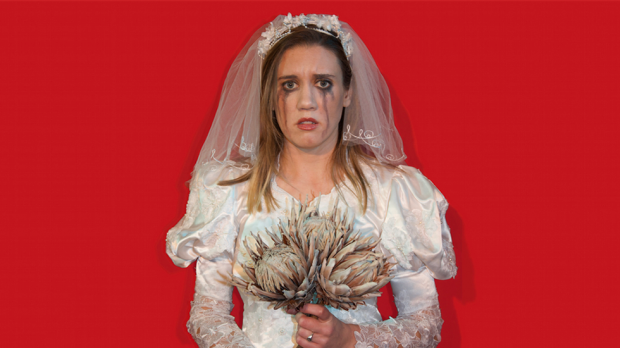
The Bride @ The Blue Room Theatre
Tuesday, February 4, 2020
As The Bride opens, the audience is ushered into a tiny, intimate, black box theatre setting. The muted lighting in the small, dark space induces a dreamy atmosphere for the feverish, fast-paced delirium to follow. A mosquito net cascades from the roof centre stage. The audience entrance doubles as a stage entrance, and there is one makeshift wing for hasty costume changes. The mise-en-scène is rough and asymmetrical, but the world represented in performance is vivid, carried by a versatile range of animated character—all embodied by one performer and the eager co-authoring of an entire audience. The wickedly funny, irreverent, and immersive one-woman show is created by and stars Nadia Collins. It offers a fresh, comic reimagining of Franz Kafka’s The Metamorphosis.
Collins embodies a host of hyperactive characters with energetic physical comedy. The characters are loveable larrikins: gruff, vulgar, croaking, and cackling in barely intelligible grunts. The scene is pre-set with Collins as an exterminator, centre stage, who banters cheekily with audience members in a broad ocker voice. With irreverence, the exterminator interrupts the pre-recorded welcome to country, dismissing the theatre and its politics as “lefty bullshit.” The presence of the exterminator, in addition to the mosquito net, foreshadows the major motif to come: the insect in both The Bride and The Metamorphosis. The eponymous bride, like Collins’ other characters, is bold, bawdy, and bogan. Post-transformation—stumbling forth through the mosquito net like a drunkard—the character remains rough-as-guts, immediately eating a slice of pizza off the floor. Unlike Kafka’s insect, which languishes and mourns its transformation, the cockroach in The Bride unapologetically embraces it with humour and humanisation.
One of the most innovative aspects of The Bride is its immersive approach. The storytelling relies heavily on the audience and its willing participation in the world of the performance. Audience members are invited to perform in a variety of roles alongside Collins. For example: as a bridesmaid, a beautician, or as the best man. Some of the saucier immersive devices engage the sensory. For example: when audience members are sprayed with insecticide and silly string or forced to eat cake, making the performance even more vivid and surreal.
In a wacky chase scene, accompanied by Benny Hill theme music, an audience member is given a torch and prompted to chase the cockroach by its light. As the cockroach, Collins squeezes in and out of entrances, wings, and passageways, crouched and bestial, rendering the monstrous Kafka-esque figure cartoonish and comical. The entire audience is immersed in a “cockroach orgy”, invited to don antennae, brandish glowsticks, and dance together. The scene transition, established through flickering coloured lights and pumping rave music, sparks a kind of primal frenzy. Each body moves in unison with the pulsating rhythm of light and sound. Unlike Kafka’s alienating insect, Collins’ cockroach celebrates communion and commonality: between audience and performance, and potentially even between human and animal.
The Kafka-esque elements of the show are especially exciting as they offer a multitude of alternative, contemporary readings for The Metamorphosis in our zeitgeist. Collins’ creative decision to perform The Bride as a one-woman show allows her to embody and enact a wide variety of metamorphoses. The gendered implications for the performance, especially read intertextually alongside Kafka’s work, are fascinating. The Metamorphosis ends on the note that the central character’s sister, Grete, has matured into womanhood and will marry soon, thus assuming the identity of bride, enabling another kind of transformation.
There is a feminist argument that the titular metamorphosis is, in fact, Grete’s, which may have influenced Collins’ decision to centralise the bride in her performance. In one gag, Collins’ cockroach releases a clutch of eggs, earning a disgusted groan from the audience. Although the image is nauseating, it effectively evokes the motif of the transformation, reminding audiences of the transitory nature of bodies—for example: in the processes of reproduction. Whereas Kafka’s The Metamorphosis grieves the transfiguration of death, Collins’ The Bride seems to celebrate the transfigurations of love, sex, friendship, and rebirth.
The Bride is dark, comic, and creative, gripping audiences with the exuberant and immersive experience it offers. This one-woman show is alive with the whirlwind, manic energy of Nadia Collins.
AMBER GALBRAITH